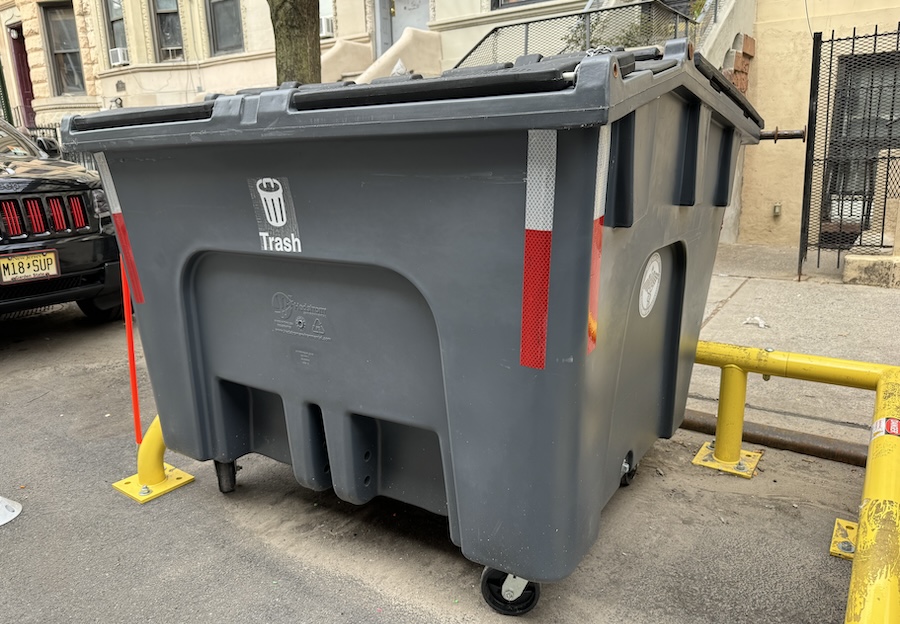The DSNY just proposed new rules for their containerization pilot program for buildings with 10+ units. Read on to learn more about what’s required for smaller buildings now, and what’s coming for bigger ones starting in Manhattan.
What Is Containerization?
Containerization is the city’s group of rules, programs, and requirements meant to get trash bags “off the street” and move waste into containers. This is in an effort to align with rules in similarly sized municipalities, and reduce rat activity citywide. Per the DSNY, “Between the commercial containerization effort and sweeping new residential rules, 70% of the city’s trash is headed into containers.”
You can learn more about Containerization in general here, at the city’s site.
Current Residential Requirements
For smaller residential properties, requirements go into effect on November 12th:
Beginning November 12, 2024, all properties with 1-9 residential units will be required to use bins, 55 gallons or less, with secure lids for trash set out.
This includes single family homes and special-use buildings receiving DSNY collection (agencies, nonprofits, houses of worship, and professional offices in residential buildings). The DSNY has been hosting ongoing virtual learning sessions with Q&As and detailed information – you can register for a future session here.
Fines for failing to comply will kick in on the above date, as well:
- $50 for the first offense
- $100 for the second offense
- $200 for the third and subsequent offenses
In June 2026, properties will be required to switch to the official NYC bin. Requirements for the official bin can be found here.
Proposed Pilot Program
Here’s where the proposed rule comes in.
Residential properties with 10+ units (split into two groups: 10 – 30 units, and 31+ units) would have specific containerization rules piloted in Manhattan Community District 9 (West Harlem, Hamilton Heights, Manhattanville, Morningside Heights) from June 1, 2025 – May 31, 2026. Per the city:
This area was chosen because it is one of the rat mitigation zones designated by the Department of Health and Mental Hygiene and it offers a very diverse set of building types and streetscapes. A portion of this area was also the subject of a much smaller scale pilot program for containerization that resulted in fewer 311 rat complaints in the area.
Buildings With 31+ Units
Buildings in this group would be required to utilize stationary on-street containers (SOSCs) rather than their own bins. The reasoning here is that “large residential buildings tend to generate too much refuse to fit in such receptacles.”
DSNY would (in conjunction with DOT) determine locations for SOSCs and affix them to the roadway in the parking lane along the curb. Buildings would not be required to use these if they receive off-street collection (loading docks) or if the DSNY determines that the building location requires alternative set-out or containerization methods.
SOSC Requirements
Per the proposal, buildings using SOSCs would be responsible for cleaning and maintaining them – including keeping them free of graffiti, trash, debris, vermin, scraps, and other unsanitary conditions. The roadway extending 1 1/2′ (aka 18″) beyond each side of the SOSC must also be kept clean.
Buildings With 10 – 30 Units
Buildings in between could either dispose refuse in SOSCs or set out appropriate bins for DSNY collection. If they choose to use SOSCs, they’d have to apply to the DSNY (tentatively beginning Dec 15, 2024 – February 1, 2025). The department would notify the building of approval or denial no later than 2 months prior to the June 1, 2025 implementation date. Either way, they’d need to have an approved method in place by June 1st per the proposed text of the law.
The hearing for this proposed rule is on November 12th – the same date requirements kick in for smaller properties. Given that the city wants to begin applications for mid-sized buildings by December 15th, it’s likely we may see approval on or around this date. You can add comments to the rule here in advance of the hearing.




